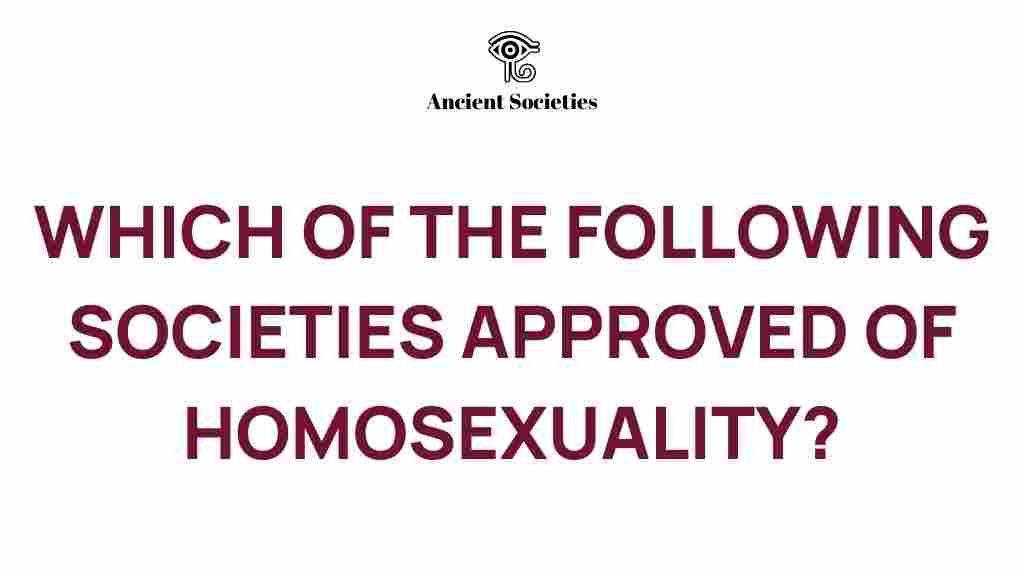Unraveling History: Which Societies Embraced Homosexuality?
Throughout history, the concept of homosexuality has been perceived and accepted in various ways across different cultures. While many societies have stigmatized or condemned homosexual relationships, others have celebrated and embraced them, reflecting a rich tapestry of human sexual orientation and cultural acceptance. In this article, we will explore ancient societies that accepted homosexuality, examining historical perspectives and societal norms that shaped their views. We will also discuss how anthropology provides insight into the LGBTQ+ history within these societies.
Understanding Homosexuality in Ancient Societies
The understanding of homosexuality and its acceptance has evolved over centuries. In many ancient civilizations, sexual orientation was not strictly defined as it is today. Instead, sexual relationships were often viewed through the lens of power dynamics, social roles, and cultural practices. Below, we delve into specific ancient societies that embraced homosexuality.
1. Ancient Greece: A Model of Acceptance
Ancient Greece is perhaps the most well-known example of a society that embraced homosexuality. The Greeks had a complex understanding of sexual relationships, particularly between men. Here are some notable aspects:
- Pederasty: This was a socially acknowledged romantic relationship between an adult male and a younger male, typically in his teens. It was considered a rite of passage for young men.
- Philosophical Acceptance: Philosophers like Plato discussed love between men in works such as “The Symposium,” highlighting its value in personal development.
- Cultural Celebrations: Festivals and plays often depicted homosexual relationships, reflecting their normalization in society.
Overall, ancient Greece’s cultural acceptance of homosexuality was influential in shaping Western understandings of sexual orientation.
2. Ancient Rome: A Complex Landscape
While ancient Rome shared some similarities with Greek culture, its views on homosexuality were more complex:
- Social Hierarchies: In Rome, the acceptance of homosexual relationships often depended on the social status of the individuals involved. It was acceptable for a freeborn Roman male to take on a passive role with male slaves or prostitutes, while the reverse was frowned upon.
- Literary References: Roman poets like Catullus and Martial wrote openly about homosexual love, showcasing a level of acceptance.
- Legal Restrictions: The emergence of legal codes in later periods began to impose restrictions on homosexual acts, particularly as Christianity gained influence.
Thus, while ancient Rome exhibited some acceptance of homosexuality, it was conditional and heavily influenced by social norms.
3. Indigenous Cultures: Two-Spirit Individuals
Many Indigenous cultures across North America recognized and respected individuals with non-binary sexual orientations, often referred to as Two-Spirit people. This term encompasses a variety of gender identities and sexual orientations within these communities:
- Cultural Significance: Two-Spirit individuals often held special spiritual roles, serving as healers or shamans.
- Community Acceptance: These individuals were integrated into their communities, which recognized multiple gender identities as part of their cultural fabric.
- Historical Context: The arrival of European colonizers often led to the suppression of these identities, but many Indigenous communities continue to honor Two-Spirit traditions today.
This illustrates how cultural acceptance of homosexuality and diverse sexual orientations can vary significantly across societies.
4. Ancient China: A Subtle Acceptance
In ancient China, homosexuality was often accepted, particularly among the elite:
- Literature and Poetry: Works from the Tang and Song dynasties celebrated same-sex love, indicating a degree of acceptance.
- Historical Figures: Emperors and scholars often had male lovers, which was not considered taboo.
- Confucian Values: While Confucianism emphasized family lineage and procreation, the complexities of human relationships allowed for the existence of homosexual love.
However, as dynasties changed and Confucian ideals became more prominent, societal norms shifted, leading to varying degrees of acceptance.
Anthropological Insights into Homosexuality
Anthropology plays a vital role in understanding how societies have perceived and accepted homosexuality throughout history. By examining archaeological findings, cultural artifacts, and historical texts, anthropologists can provide valuable context to the evolution of sexual orientation and societal norms.
The Role of Anthropology
Anthropologists study:
- Cultural Practices: Rituals and ceremonies that celebrate same-sex relationships can offer insight into the societal acceptance of homosexuality.
- Gender Roles: Understanding how different cultures define and express gender can illuminate the fluidity of sexual orientation.
- Historical Context: Analyzing historical documents and artifacts helps reconstruct the views and practices related to homosexuality in ancient societies.
Through these lenses, anthropologists reveal that acceptance of homosexuality has varied widely based on cultural, geographical, and temporal factors.
Challenges and Misconceptions
Despite historical evidence of acceptance, misconceptions about homosexuality persist. Some common challenges include:
- Modern Bias: Contemporary views may color our understanding of historical practices, leading to misinterpretations.
- Assumption of Homophobia: The belief that all societies have uniformly condemned homosexuality ignores the diversity of views across cultures.
- Neglect of Non-Western Perspectives: Western-centric narratives often overlook the rich histories of LGBTQ+ identities in non-Western societies.
Addressing these challenges requires a nuanced understanding of history and a commitment to recognizing the complexity of human sexuality.
Conclusion: Embracing Diversity in History
The exploration of ancient societies that embraced homosexuality highlights the diverse perspectives on sexual orientation throughout history. From the acceptance found in ancient Greece and Rome to the revered status of Two-Spirit individuals in Indigenous cultures, we see a rich legacy of cultural acceptance that challenges modern assumptions.
As we continue to unravel the historical perspectives surrounding homosexuality, it becomes clear that societal norms are not static. They evolve, influenced by cultural, religious, and political changes. Understanding this history is crucial for fostering a more inclusive society today.
For further reading on LGBTQ+ history, consider exploring resources from the LGBTQ+ History Project to gain deeper insights into how various cultures have embraced sexual diversity.
In our journey through history, let us remember that acceptance and understanding of diverse sexual orientations are not just modern ideals, but are deeply rooted in our shared human experience.
This article is in the category Culture and created by AncientSocieties Team
